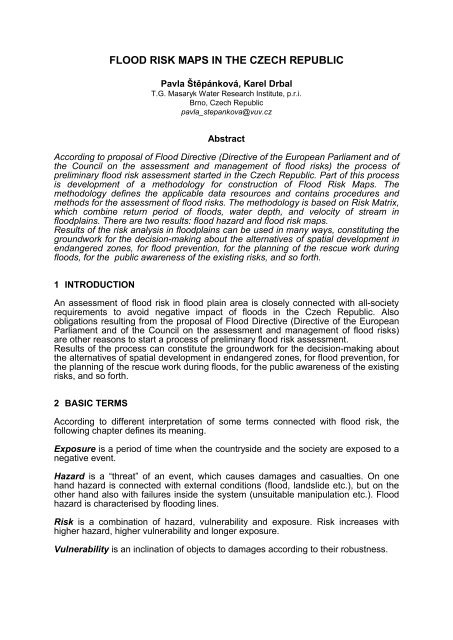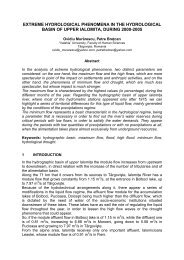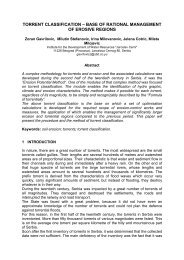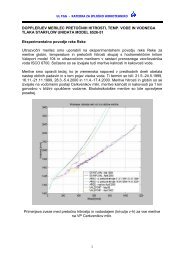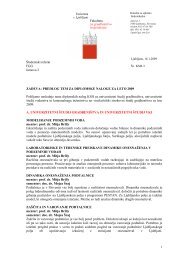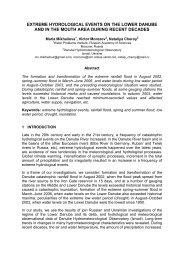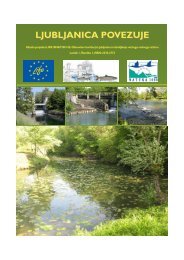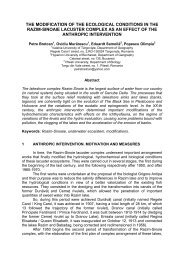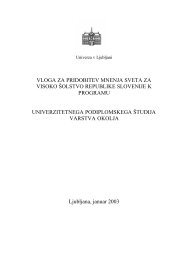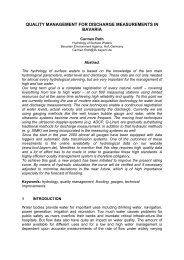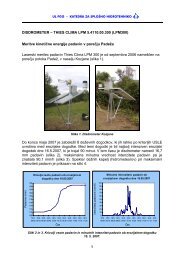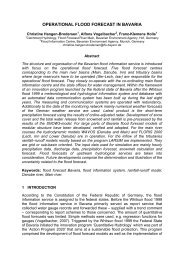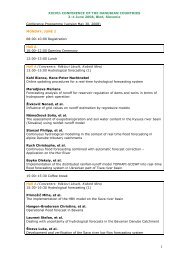FLOOD RISK MAPS IN THE CZECH REPUBLIC - sh.fgg.uni-lj.si
FLOOD RISK MAPS IN THE CZECH REPUBLIC - sh.fgg.uni-lj.si
FLOOD RISK MAPS IN THE CZECH REPUBLIC - sh.fgg.uni-lj.si
You also want an ePaper? Increase the reach of your titles
YUMPU automatically turns print PDFs into web optimized ePapers that Google loves.
<strong>FLOOD</strong> <strong>RISK</strong> <strong>MAPS</strong> <strong>IN</strong> <strong>THE</strong> <strong>CZECH</strong> <strong>REPUBLIC</strong>Pavla Štěpánková, Karel DrbalT.G. Masaryk Water Research Institute, p.r.i.Brno, Czech Republicpavla_stepankova@vuv.czAbstractAccording to proposal of Flood Directive (Directive of the European Parliament and ofthe Council on the assessment and management of flood risks) the process ofpreliminary flood risk assessment started in the Czech Republic. Part of this proces<strong>si</strong>s development of a methodology for construction of Flood Risk Maps. Themethodology defines the applicable data resources and contains procedures andmethods for the assessment of flood risks. The methodology is based on Risk Matrix,which combine return period of floods, water depth, and velocity of stream infloodplains. There are two results: flood hazard and flood risk maps.Results of the risk analy<strong>si</strong>s in floodplains can be used in many ways, constituting thegroundwork for the deci<strong>si</strong>on-making about the alternatives of spatial development inendangered zones, for flood prevention, for the planning of the rescue work duringfloods, for the public awareness of the existing risks, and so forth.1 <strong>IN</strong>TRODUCTIONAn assessment of flood risk in flood plain area is closely connected with all-societyrequirements to avoid negative impact of floods in the Czech Republic. Alsoobligations resulting from the proposal of Flood Directive (Directive of the EuropeanParliament and of the Council on the assessment and management of flood risks)are other reasons to start a process of preliminary flood risk assessment.Results of the process can constitute the groundwork for the deci<strong>si</strong>on-making aboutthe alternatives of spatial development in endangered zones, for flood prevention, forthe planning of the rescue work during floods, for the public awareness of the existingrisks, and so forth.2 BASIC TERMSAccording to different interpretation of some terms connected with flood risk, thefollowing chapter defines its meaning.Exposure is a period of time when the country<strong>si</strong>de and the society are exposed to anegative event.Hazard is a “threat” of an event, which causes damages and casualties. On onehand hazard is connected with external conditions (flood, landslide etc.), but on theother hand also with failures in<strong>si</strong>de the system (unsuitable manipulation etc.). Floodhazard is characterised by flooding lines.Risk is a combination of hazard, vulnerability and exposure. Risk increases withhigher hazard, higher vulnerability and longer exposure.Vulnerability is an inclination of objects to damages according to their robustness.
3 PR<strong>IN</strong>CIPAL FEATURES OF <strong>THE</strong> METHODOLOGYA. Procedures recommended by the methodology have been connected to theutmost to standard database establi<strong>sh</strong>ed, operated and administrated within theCzech Republic by following providers:• Czech Office for Surveying, Mapping and Cadastre (http://www.cuzk.cz/)• Czech Statistical Office (http://www.czso.cz/)• Institute for Spatial Development (http://www.uur.cz/)• M<strong>uni</strong>cipalitiesB. Application ways of outputs, reliability and acces<strong>si</strong>bility of input data, costs relatedto respective solution have defined a detailed degree with a view of threatened areain terms of specifying areas of suitable procedures and methods for two regionallevels (Fig. 1):• I – region, district or otherwise defined area or its part,• II – structure, object.Figure 1. Ba<strong>si</strong>c input data, resolution levels and users of output results4 PROCEDURE OF <strong>FLOOD</strong> <strong>RISK</strong> ASSESSMENTIdentification of flood hazardThe flood hazard is described by maps of flood hazard, which characterize flooddevelopment in floodplains. We can mention the following:• flooding line
• water depth• velocity of streamAll of them are determined for return period of floods for 5, 20 and 100 years. Thesedata are obtained from hydrodynamic models and from information about floods inthe past.Method of Risk MatrixThe method of Risk Matrix belongs to semi-quantitative methods of the riskassessment. The methods use appropriate numerous or colour scales for riskexpres<strong>si</strong>on. The vulnerability is not included there in the first step; it is usuallyexpressed by acceptable risk or necessary measurements in floodplains.The Risk Matrix represents one of the ea<strong>si</strong>est procedures for preliminary flood riskassessment. The method does not require quantitative assessment of loses.Risk is con<strong>si</strong>dered as a function of probability of exceeding and inten<strong>si</strong>ty of flood(Fig. 2) in this method. The inten<strong>si</strong>ty of flood expresses a devastating impact of flood,which depends on a water depth and a velocity of stream. Used Risk Matrix stemsfrom “the Switzerland Methodology” (Beffa, 2000).The results of Risk Matrix are maps of hazard in the first step (Fig. 3). Theyrepresent categories of threatened areas in floodplains by coloured scale. Thesecategories allow assessment of contemporary or future land use suitability andrecommend type of future use for areas with higher level of hazard (Tab. 1). Thisprocess can be used in spatial development, for flood prevention policies etc.
Figure 2. Schema of Risk Matrix Method (arranged according Říha et all, 2006)
Figure 3. Map of hazard - example (Říha a kol., 2006)Table 1. Clas<strong>si</strong>fication and description of hazard in floodplains according to RiskMatrix methodHazard RI(Beffa, 2000)RI > 0,1 or IP > 30,01 < RI < 0,1RI < 0,01P > 0,0033Category ofhazard(4) High(red colour)(3) Middle(blue colour)(2) Low(orange colour)(1) Re<strong>si</strong>dual(yellow colour)RecommendationIt is not recommended to either allow new or extendrecent build-up area, where people or animal can live.For recent build-up areas suggest such floodprotection, which will reduce risk to acceptable level.Development is pos<strong>si</strong>ble with some restrictionsresulted from detailed analy<strong>si</strong>s of potential floodhazard. Build-up of sen<strong>si</strong>tive objects (e.g. hospitals,schools, fire station etc.) is unsuitable there. It is notrecommended to extend recent build-up area.New development is pos<strong>si</strong>ble. Estate owners have tobe informed about potential flood hazard. Sen<strong>si</strong>tiveobjects have to be protected against flood.Flood protection is solved by long-term planning ofland use zoning focused on especially sen<strong>si</strong>tiveobjects (health care institution, historical objects etc.)Maps of risk (Fig. 4) arise in the second step of described procedure. They combineinformation about hazard and about vulnerability of objects in floodplain. Informationabout vulnerability can be obtained from planning document of land use zoning,general maps and field work. Based on these information classes of functional landuse are set (tab. 2 – column “Functional regulation”). Value of maximal acceptablerisk is determined for each of the classes (tab. 2 – “Maximal acceptable risk”).
Figure 4. Map of risk - example (Říha et all, 2006)Maps of risk <strong>sh</strong>ow areas where maximal acceptable risk is exceeded. In the areasvalues of hazard are expressed in scale of table 1. These zones have to be reviewedin terms of risk management and pos<strong>si</strong>bility of risk reduction.Tab. 2 Classes of functional land use according to planning document of land usezoningNotationFunctional regulationMaximalacceptable hazardBY Living LowDO Transport and technical infrastructure LowOV Civic amenities LowVY Production LowZV Agricultural production LowSR Sport and collective recreation MiddleLE Forests, greenery HighOP Arable land, meadows, grazing High
5 CONCLUSIONThe methodology is focused on risk analy<strong>si</strong>s in floodplains. It determinates usablesource of data in the Czech Republic, procedures and methods for assessment offlood hazard consequences. Proposed methods and approaches were verified in apilot area on part of the Elbe River in the Czech Republic. According to high level ofimportance of the topic, in the next step, the methodology will be included in adirective of the Ministry of Environment of the Czech Republic and in some otherlegislative and economic directives.Described procedures are results of the project “Methodology Proposal forDetermination of Flood Risks and Damages within a Floodplain Area andMethodology Verification in the Elbe River Ba<strong>si</strong>n” (Drbal et all, 2005) financed byMinistry of Environment of the Czech Republic.ReferencesBeffa, C. (2000): A Statistical Approach for Spatial Analy<strong>si</strong>s of Flood Prone Areas. InternationalSympo<strong>si</strong>um on Flood Defense, D-Kassel, September 2000.Drbal, K. et all (2005): Methodology Proposal for Determination of Flood Risks and Damages within aFloodplains and Methodology Verification in the Elbe River Ba<strong>si</strong>n (in Czech). TGM WRI Brno, 150 p.Drbal, K. et all (2006): Map of Flood Risk – River Jihlava (in Czech). TGM WRI Brno, 36 p.Říha, J. et all (2006): Evaluation of Spring Flood 2006 in the Czech Republic – Risk Analy<strong>si</strong>s (RiverSvratka, River Svitava) (in Czech). Brno Univer<strong>si</strong>ty of Technology, Faculty of Civil Engineering,Institute of Water Structures, 38 p.


